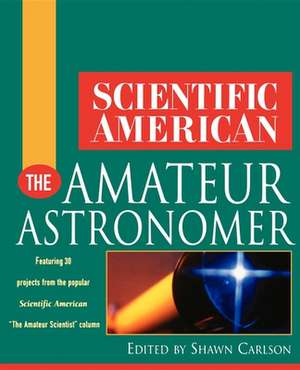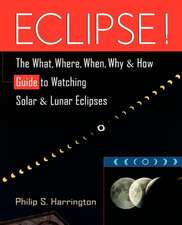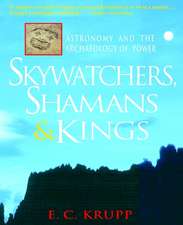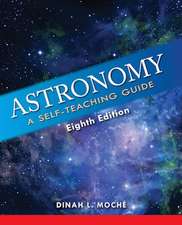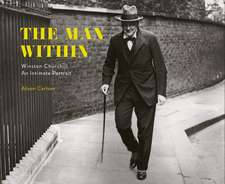Scientific American the Amateur Astronomer
Autor Scientific American Magazine, Marilyn Carlson Nelson, John Ed. Carlsonen Limba Engleză Paperback – 15 ian 2001
For over seventy years, "The Amateur Scientist" column in Scientific American has helped people explore their world and make original discoveries. This collection of both classic and recent articles presents projects for amateur astronomers at all levels. Hands–on astronomy fans will find how to build inexpensive astronomical instruments using ordinary shop–tools. From making a telescope to predicting satellite orbits to detecting the chemical composition of faraway stars, this book has something for everyone interested in practical astronomy.
Preț: 117.32 lei
Nou
Puncte Express: 176
Preț estimativ în valută:
22.45€ • 23.14$ • 18.96£
22.45€ • 23.14$ • 18.96£
Carte disponibilă
Livrare economică 10-24 februarie
Preluare comenzi: 021 569.72.76
Specificații
ISBN-13: 9780471382829
ISBN-10: 0471382825
Pagini: 288
Dimensiuni: 191 x 235 x 15 mm
Greutate: 0.5 kg
Editura: Wiley
Locul publicării:Hoboken, United States
ISBN-10: 0471382825
Pagini: 288
Dimensiuni: 191 x 235 x 15 mm
Greutate: 0.5 kg
Editura: Wiley
Locul publicării:Hoboken, United States
Public țintă
High School and College Science Students and Teachers and Science Buffs.Descriere
Are you an avid sky–watcher? Would you like to observe the changes in the moon′s surface? Predict the orbit of a satellite? Record sunspots?
Finally, here is the book you′ve been waiting for! From the longest–running column in Scientific American′s history comes this collection of fascinating projects for the amateur astronomer. Whether you′re interested in designing your own telescope or determining the chemical composition of faraway stars, this unique book will help you satisfy your passion for the skies. You′ll learn how to build and use astronomical tools that will help you better understand and appreciate the solar system, our galaxy, and the cosmos.
Here you′ll discover fascinating facts about astronomy along with helpful tips and clear instructions on how to build inexpensive astronomical instruments in home–based workshops using ordinary shop tools. From making a pendulum that detects the earth′s rotation, to observing Jupiter with a homemade telescope, to taking picture–perfect images of a comet, these projects will help you go deeper into space than you′ve ever imagined.
Finally, here is the book you′ve been waiting for! From the longest–running column in Scientific American′s history comes this collection of fascinating projects for the amateur astronomer. Whether you′re interested in designing your own telescope or determining the chemical composition of faraway stars, this unique book will help you satisfy your passion for the skies. You′ll learn how to build and use astronomical tools that will help you better understand and appreciate the solar system, our galaxy, and the cosmos.
Here you′ll discover fascinating facts about astronomy along with helpful tips and clear instructions on how to build inexpensive astronomical instruments in home–based workshops using ordinary shop tools. From making a pendulum that detects the earth′s rotation, to observing Jupiter with a homemade telescope, to taking picture–perfect images of a comet, these projects will help you go deeper into space than you′ve ever imagined.
Textul de pe ultima copertă
Are you an avid sky–watcher? Would you like to observe the changes in the moon′s surface? Predict the orbit of a satellite? Record sunspots?
Finally, here is the book you′ve been waiting for! From the longest–running column in Scientific American′s history comes this collection of fascinating projects for the amateur astronomer. Whether you′re interested in designing your own telescope or determining the chemical composition of faraway stars, this unique book will help you satisfy your passion for the skies. You′ll learn how to build and use astronomical tools that will help you better understand and appreciate the solar system, our galaxy, and the cosmos.
Here you′ll discover fascinating facts about astronomy along with helpful tips and clear instructions on how to build inexpensive astronomical instruments in home–based workshops using ordinary shop tools. From making a pendulum that detects the earth′s rotation, to observing Jupiter with a homemade telescope, to taking picture–perfect images of a comet, these projects will help you go deeper into space than you′ve ever imagined.
Finally, here is the book you′ve been waiting for! From the longest–running column in Scientific American′s history comes this collection of fascinating projects for the amateur astronomer. Whether you′re interested in designing your own telescope or determining the chemical composition of faraway stars, this unique book will help you satisfy your passion for the skies. You′ll learn how to build and use astronomical tools that will help you better understand and appreciate the solar system, our galaxy, and the cosmos.
Here you′ll discover fascinating facts about astronomy along with helpful tips and clear instructions on how to build inexpensive astronomical instruments in home–based workshops using ordinary shop tools. From making a pendulum that detects the earth′s rotation, to observing Jupiter with a homemade telescope, to taking picture–perfect images of a comet, these projects will help you go deeper into space than you′ve ever imagined.
Cuprins
Foreword.
Introduction.
TELESCOPE MAKING.
A Simple Telescope for Beginners.
How to Grind, Polish and Test an Aluminum Telescope Mirror.
The Behavior of the Telescope–maker′s Pitch.
The Dall–Kirkham Telescope.
Principles of Erecting Telescopes.
Powerful Pocket Telescopes.
A Novel Refracting Telescope.
"Off–Axis" Reflecting Telescopes.
Steady Telescope Mountings.
Two Amateur–Built Radio Telescopes.
THE SUN.
How to Observe and Record Sunspots Safely.
Sun of a Gun.
A Coronagraph to View Solar Prominences.
Two Spectroheliographs for Observe the Solar Disk.
THE EARTH, MOON, AND SATELLITES.
A Pendulum That Detects the Earth′s Rotation.
Observing Changes on the Moon.
Curious Amateur Observations of the Moon.
A Pauper′s Guide to Measuring Latitude.
Precision Geolocation Using Lunar Occultation.
Sundial Potpourri.
How to Study Artificial Satellites.
Predicting Satellite Orbits.
THE PLANETS, COMETS, AND STARS.
Amateur Observations of Jupiter.
Predicting Planetary Alignments.
Catch a Comet by Its Tail.
A Picture–Perfect Comet.
A Device to Simulate Planetary Orbits.
An Astrophysical Laboratory in Your Backyard.
An Ocular Spectroscope.
Monitoring Variable Stars.
Glossary.
Further Reading.
Contact List.
Index.
Introduction.
TELESCOPE MAKING.
A Simple Telescope for Beginners.
How to Grind, Polish and Test an Aluminum Telescope Mirror.
The Behavior of the Telescope–maker′s Pitch.
The Dall–Kirkham Telescope.
Principles of Erecting Telescopes.
Powerful Pocket Telescopes.
A Novel Refracting Telescope.
"Off–Axis" Reflecting Telescopes.
Steady Telescope Mountings.
Two Amateur–Built Radio Telescopes.
THE SUN.
How to Observe and Record Sunspots Safely.
Sun of a Gun.
A Coronagraph to View Solar Prominences.
Two Spectroheliographs for Observe the Solar Disk.
THE EARTH, MOON, AND SATELLITES.
A Pendulum That Detects the Earth′s Rotation.
Observing Changes on the Moon.
Curious Amateur Observations of the Moon.
A Pauper′s Guide to Measuring Latitude.
Precision Geolocation Using Lunar Occultation.
Sundial Potpourri.
How to Study Artificial Satellites.
Predicting Satellite Orbits.
THE PLANETS, COMETS, AND STARS.
Amateur Observations of Jupiter.
Predicting Planetary Alignments.
Catch a Comet by Its Tail.
A Picture–Perfect Comet.
A Device to Simulate Planetary Orbits.
An Astrophysical Laboratory in Your Backyard.
An Ocular Spectroscope.
Monitoring Variable Stars.
Glossary.
Further Reading.
Contact List.
Index.
Recenzii
An anthology of interest to the backyard astronomer, from America′s leading science magazine. "The Amateur Scientist," as Carlson points out in his brief introduction, has run in Scientific American for over 70 years. From the Start, it has been written for the amateur interested in making observations of various celestial phenomena, often with homemade equipment. The collection of articles from those years is updated to reflect the changes both in technology and in society at large (many supply houses and research sources, for example are now most easily found online). Most of the pieces assume considerable dedication to the task at hand: grinding a telescope mirror (a frequent first project for young scientists), while comparatively inexpensive, involves a substantial investment of time to achieve a precision component. Technical and mathematical sophistication is a given here; readers uncomfortable with equations will soon find themselves at sea. But for those who want to do hands–on science, this is a gold mine: it offers several variations on the basic reflecting telescope, as well as tips on taking astronomical photos and designs for an ocular spectroscope. For those who want to explore beyond the visual spectrum, it gives plans for two homemade radio telescopes. The study of artificial satellites (unheard of in the early days of the column) occupies two chapters. Other projects include two novel sundials (one based on a globe of the earth), instruments to stimulate planetary orbits and pointers on observing specific objects (such as the moon or Jupiter). Where relevant (for example, in regard to solar observations) there are ample safety tip. The writing is for the most part clear, although technical terms are necessarily plentiful.
Certainly not for everyone, but for its intended audience this is an indispensable book.
––Kirkus Reviews, December 1, 2000
Certainly not for everyone, but for its intended audience this is an indispensable book.
––Kirkus Reviews, December 1, 2000
Notă biografică
SCIENTIFIC AMERICAN magazine reaches more than three million readers globally by subscription, on newsstands, and online at www.sciam.com. The company also publishes Scientific American Explorations, a quarterly family magazine, and Scientific American Archive, an online archive of issues from 1993 to the present at www.sciamarchive.com. SHAWN CARLSON has authored Scientific American′s "The Amateur Scientist" column since 1995. He is the Executive Director of the Society for Amateur Scientists and a 1999 winner of the prestigious MacArthur Foundation "genius" Fellowship.
